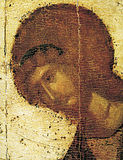

| Previous day | Next day |
| Old Style
March 26
|
Monday |
New Style
April 8
|
|
5th Week of Great Lent.
Tone 4.
Great Lent. |
Monastic rule: xerophagy (bread, uncooked fruits and vegetables).
|
![]() Synaxis of the Archangel Gabriel.
Synaxis of the Archangel Gabriel.
![]() Hieromartyr Irenaeus, bishop of Sirmium (304).
Hieromartyr Irenaeus, bishop of Sirmium (304). ![]() Hieromartyrs Bathusius and Bercus, priests, Monk-martyr Arpilus, and Martyrs Abibus, Agnus, Reasus, Igathrax, Iscoeus (Iskous, Escoes), Silas, Signicus, Sonerilas, Suimbalus, Thermus, Phillus (Philgas), Anna, Alla, Larissa, Monco (Manca), Mamica, Uirko (Virko), Animais (Animaida), Gaatha the queen of the Goths, and Duklida, in the Crimea (ca. 375). St. Malchus of Chalcis in Syria (4th c.). St. Basil the Younger, anchorite, near Constantinople (10th c.).
Hieromartyrs Bathusius and Bercus, priests, Monk-martyr Arpilus, and Martyrs Abibus, Agnus, Reasus, Igathrax, Iscoeus (Iskous, Escoes), Silas, Signicus, Sonerilas, Suimbalus, Thermus, Phillus (Philgas), Anna, Alla, Larissa, Monco (Manca), Mamica, Uirko (Virko), Animais (Animaida), Gaatha the queen of the Goths, and Duklida, in the Crimea (ca. 375). St. Malchus of Chalcis in Syria (4th c.). St. Basil the Younger, anchorite, near Constantinople (10th c.).
Martyr Codratus (Quadratus), and with him 40 Martyrs, who suffered under Diocletian (284-305). Hieromartyr Eusebius, bishop of Kival, and Martyr Pullius the Reader. Hieromartyr Montanus, priest, and his wife Maxima, at Sirmium (ca. 304). St. Eutychius, subdeacon, of Alexandria (356). St. Braulio of Saragossa in Iberia (646). St. Ludger, bishop of Munster and missionary to northwestern Germany (809). New Martyr George of Sofia, at Adrianople (1437). St. Stephen the Confessor and Wonderworker, abbot, of Tryglia (815).
Thoughts for Each Day of the Year
According to the Daily Church Readings from the Word of God
By St. Theophan the Recluse

Monday (the 5th week of Lent).
The eyes of the Lord are in every place, beholding the evil and the good (Prov. 15:3). Oh, if only rational creatures would always keep this in mind! Then not only would they not dare to commit excesses openly and to give themselves over to dissoluteness of the flesh, but also inwardly, in their thoughts, and in the movements of their heart, they would not allow anything unpleasing to God. They would stand then like soldiers at the front before the king, with all attention and strictness toward themselves, that they not be found ignorant of their orders, and not be subject to the king’s wrath and punishment. The orders given to rational creatures are the commandments of God, which determine the proper form of their thoughts, and how their feelings and dispositions ought to be; they would then be quite well-ordered.
Articles
 Hieromartyr Irenaeus the Bishop of SirmiumHieromartyr Irenaeus suffered during the persecution against Christians under the Roman emperors Diocletian and Maximian (284-305). |
 Saint Malchus of Chalcis in SyriaSaint Malchus was the only son of a farmer, and lived near Antioch, Syria. |
 Venerable Basil the New, Anchorite, Near ConstantinopleSaint Basil the New left the world in his youth, and struggled in a desolate place. |


